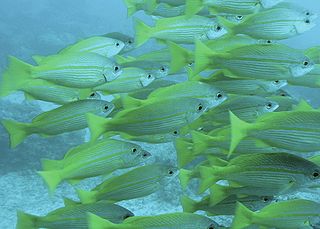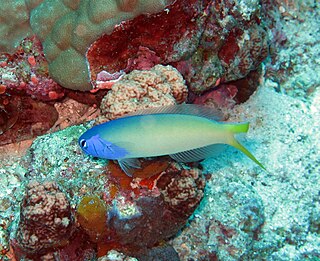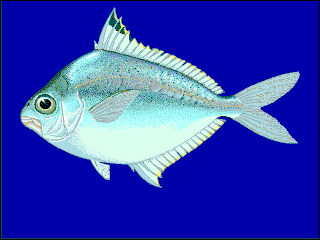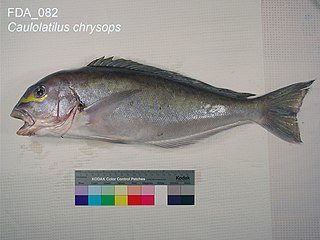
Tilefishes are mostly small perciform marine fish comprising the family Malacanthidae. They are usually found in sandy areas, especially near coral reefs. They have a long life span, up to 46 years (females) and 39 years (males).

Emmelichthys nitidus, the Cape bonnetmouth, bonnetmouth, redbait, pearl fish, picarel, red baitfish, red herring or Southern rover, is a species of marine ray-finned fish belonging to the family Emmelichthyidae, the rovers and bonnetmouths. This species is found in the Indian and Pacific oceans. This species is of minor importance to commercial fisheries.

The rubyfish, also known as the cosmopolitan rubyfish, red ruby or ruby rover, is a species of marine ray-finned fish, belonging to the family Emmelichthyidae, the rovers, bonnetmouths and rubyfishes. This species is found from the southeastern Atlantic Ocean off South Africa through the Indian Ocean to the southwestern Pacific Ocean around Australia and New Zealand. This species is commercially important.

The bigeye snapper, also known as the bigeye seaperch, red sea lined snapper, golden striped snapper, rosy snapper, yellow snapper, or simply snapper, is a species of marine ray-finned fish, a snapper belonging to the family Lutjanidae. It is native to the Indian Ocean and the western Pacific Ocean. It is the type species of the genus Lutjanus.

Hoplolatilus starcki, Stark's tilefish, purple-headed sand tilefish or bluehead tilefish, is a species of marine ray-finned fish, a tilefish belonging to the family Malacanthidae. This species is native to the central Indo-Pacific.

Hoplolatilus marcosi, the redback sand tilefish, is a species of marine ray-finned fish, a tilefish belonging to the family Malacanthidae. It is native to the western central Pacific Ocean.

The ocean whitefish, also known as the ocean tilefish, is a species of marine ray-finned fish, a tilefish belonging to the family Malacanthidae. It is native to the eastern Pacific Ocean.

Caulolatilus cyanops, the blackline tilefish or ocean whitefish, is a species of marine ray-finned fish, a tilefish belonging to the family Malacanthidae. It is found in the western Atlantic Ocean.

The Gulf bareye tilefish, also known as the anchor tilefish, is a species of marine ray-finned fish, a tilefish belonging to the family Malacanthidae. It occurs in the western Atlantic Ocean.

The blackfin snapper, also known as the blackspot snapper, blackfin red snapper, gun-mouth backfin, gun-mouth snapper, redfish and wrenchman is a species of marine ray-finned fish, a snapper belonging to the family Lutjanidae. It is native to the western Atlantic Ocean. It is a commercially important species, though it has been reported to carry the ciguatera toxin.

The blue blanquillo, also known as the banded blanquillo, striped blanquillo, false whiting, sand tilefish or eye of the sea, is a species of marine ray-finned fish, a tilefish belonging to the family Malacanthidae. It is found in the Indo-Pacific.

Branchiostegus is a genus of marine ray-finned fishes, tilefishes, belonging to the family Malacanthidae. They are found in the eastern Atlantic Ocean through the Indian Ocean to the western Pacific Ocean. Here they create burrows in soft substrates in the comparatively deep waters of the continental shelf and slope.

Eubleekeria splendens, common names splendid ponyfish and blacktip ponyfish, is a species of ponyfish.

Nemipterus japonicus, the Japanese threadfin bream, is a species of marine ray-finned fish belonging to the family Nemipteridae, the threadfin and whiptail breams. This species is found in the Indo Pacific region and is an important food fish.
Microcotyle branchiostegi is a species of monogenean, parasitic on the gills of a marine fish. It belongs to the family Microcotylidae.

Malacanthus brevirostris, the quakerfish, flagtail blanquillo, false whiting or stripetail tilefish, is a species of marine ray-finned fish, a tilefish belonging to the family Malacanthidae. It has a wide Indo-Pacific distribution.

Caulolatilus chrysops, the Atlantic goldeneye tilefish or gold face tilefish, is a species of marine ray-finned fish, a tilefish belonging to the family Malacanthidae. It occurs in the western Atlantic Ocean.

Caulolatilus hubbsi, the Hubbs's tilefish, is a species of marine ray-finned fish, a tilefish belonging to the family Malacanthidae. It occurs in the eastern Pacific Ocean. Its specific name honours the American ichthyologist Carl Leavitt Hubbs (1894-1979). Studies have shown that this taxon is not readily distinguishable from Caulolatilus princeps and should be treated as a junior synonym of C. princeps.

Malacanthus plumieri, the sand tilefish, is a species of marine ray-finned fish, a tilefish belonging to the family Malacanthidae. It is found in the western Atlantic Ocean.
The yellowtail croaker, also known as the yellowtail jewfish, is a species of marine ray-finned fish belonging to the family Sciaenidae, the drums and croakers. This species is found in the southwestern Pacific Ocean off northern Australia and southern New Guinea. It is the only species in the monospecific genus Austronibea.



















